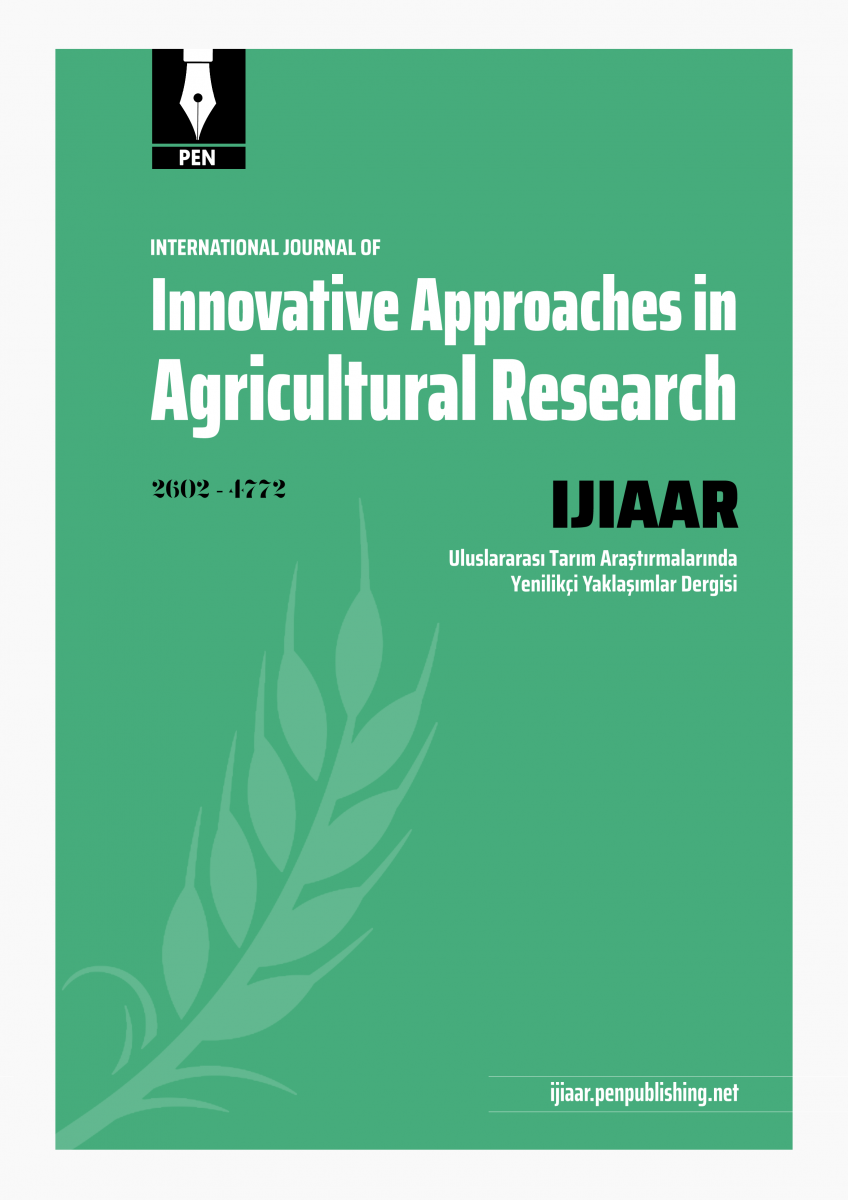- Atlamaz A., Zeki C., & Uludag A. (2007). The importance of forecasting and warn- ing systems in implementation of integrated pest management in apple orchards in Turkey. EPPO Bulletin, 37(2): 295–299. [Google Scholar]
- Aydemir, C., (2008). Ekonomik Gelişme Sürecinde Tarım-Sanayi İlişkilerinin Sektörler Arası Bütünleşmeye Etkileri, Dicle Üniversitesi Ziya Gökalp Eğitim Fakültesi Dergisi (DUZGEFD), Year 2008, Issue: 10, 129 – 147. [Google Scholar]
- Blauw, A. N., Anderson, P., Estrada, M., Johansen, M., Laanemets, J., & Peperzak, L., (2006). The use of fuzzy logic for data analysis and modeling of European harmful algal blooms: results of the HABES project. African Journal of Marine Science, 28(2),365-369. [Google Scholar]
- Burrack, H. J., Connell, J. H., & Zalom, F. G., (2008). Comparison of Olive Fruit Fly Bactrocera Oleae Gmelin Diptera: Tephritidae Captures in Several Commercial Traps in California. International Journal of Pest Management 54:3, pages 227-234. [Google Scholar]
- Dhehibi, B., Rudiger, U., Moyo, H. P., & Dhraief, M. Z. (2020). Agricultural technology transfer preferences of smallholder farmers in Tunisia’s arid regions. Sustainability (Switzerland), 12(1). https://doi.org/10.3390/SU12010421. [Google Scholar] [Crossref]
- Doitsidis, L., Fouskitakis, G. N., Varikou, K. N., Rigakis, I. I., Chatzichristofis, S. A., Papafilippaki, A. K. & Birouraki, A. E. (2019). Remote monitoring of the Bactrocera oleae (Gmelin) (Diptera: Tephritidae) population using an automated McPhail trap. Computers and Electronics in Agriculture. [Google Scholar]
- Francis, C.A., Flora, C.B., & King, L.d., (1990). Sustainable agriculture in temperate zones, New York and Chichester. 487 pp. Agricultural Systems, Elsevier, vol. 36(2) ISBN 0-471-62227-3. [Google Scholar]
- Friocourt, Y. F., Skogen, M., Stolte, W., & Albretsen, J. (2012). Marine downscaling of a future climate scenario in the North Sea and possible effects of dinoflagellate harmfulalgal blooms. Food Additives and Contaminants A, 29(10), 1630-1646. [Google Scholar]
- Goncalves M.F.M., Rodrigues M.C., & Torres L.M. (2008). Susceptibility of Cobranc¸osa, Madural and Verdeal Transmontana varieties to olive fruit fly, Bactrocera oleae (Gmelin), under laboratory conditions. I Congresso Nacional de Produc¸a˜o Integrada/VIII Encontro Nacional de Protecc¸a˜o Integrada, Ponte de Lima, 20 e 21 de Novembro, pp 379–388 (in Portuguese with an English abstract). [Google Scholar]
- Kontodimas, C. (2012). Pest Management Control of Olive Fruit fly (Bactrocera oleae) Based on a Location-Aware Agro-Environmental System. Computers and Electronics in Agriculture 87(39-50). [Google Scholar]
- Liu, R., Wang, H., Guzma, J.L., & Li, M. (2022). A model-based methodology for the early warning detection of cucumber downy mildew in greenhouses: An experimental evaluation. Computers and Electronics in Agriculture 194 -106751. [Google Scholar]
- Maesano, G., Chinnici, G., Falcone, G., Bellia, C., Raimondo, M., & D’amico, M. (2021). Economic and environmental sustainability of olive production: A case study. Agronomy, 11(9), 1–22. https://doi.org/10.3390/agronomy11091753 [Google Scholar] [Crossref]
- Mezei.I., Milan, L., & Berbakov, L. (2022). Grapevine Downy Mildew Warning System Based on NB-IoT and Energy Harvesting Technology, MDPİ11(3), 356. [Google Scholar]
- Özaltaş, M., Savran, M.K., Ulaş, M., Kaptan, S., & Köktürk, H. (2016). Türkiye Zeytincilik Sektör Raporu, ISBN: 978-605-9175-57-9. SS: 302. [Google Scholar]
- Pakdemirli, B., Birişik, N., Aslan, İ., Sönmez B., & Gezici M., (2021). Türk Tarımında Dijital Teknolojilerin Kullanımı ve Tarım-Gıda Zincirinde Tarım 4.0, Toprak Su Dergisi. 2021; 10(1): 78-87. [Google Scholar]
- Pontikakos, C. M., Theodore, A., Constantine Yialouris, P., Tsiligiridis, D., & Rehman, A., Saba, T., Kashif, M., Fati, S. M., Bahaj, S. A., & Chaudhry, H. (2022). A Revisit of Internet of Things Technologies for Monitoring and Control Strategies in Smart Agriculture. Agronomy, 12(1), 1–21. https://doi.org/10.3390/agronomy12010127. [Google Scholar] [Crossref]
- Saygılı, F., Kaya, A.A., Çalışkan, E.T., & Kozal, Ö.E., (2019). Türk Tarımının Global Entegrasyonu Ve Tarım 4.0, Proje Sonuç Raporu, ISBN:978-605-137-710-0. SS.100. [Google Scholar]
- Topuz, H., & Durmusoglu, E. (2008). The effect of early harvest on infestation rate of Bactrocera oleae (Gmelin) (Diptera: Tephritidae) as well as yield, acidity and fatty acid composition of olive oil. Journal of Plant Diseases and Protection, 115(4), 186-191. [Google Scholar]
- Tunç, C., & Onoğur, E. (2013). Güncel Verilerle Zeytin Halkalı Leke Hastalığı. Anadolu, Ege Tarımsal Araştırma Enstitüsü Dergisi, 23(2), 44-60. [Google Scholar]
- Turhan, Ş., (2005). Tarımda Sürdürülebilirlik Ve Organik Tarım, Tarım Ekonomisi Dergisi, 2005; 11(1) : 13 – 24. [Google Scholar]
- Xu X. M., Robinson J. (2005). Modeling the effects of wetness duration and fruit maturity on infection of apple fruits of Cox’s orange Pippin and two clones of gala by Venturia in a equalis. Plant Pathology, 54(3): 347–356. [Google Scholar]
|

